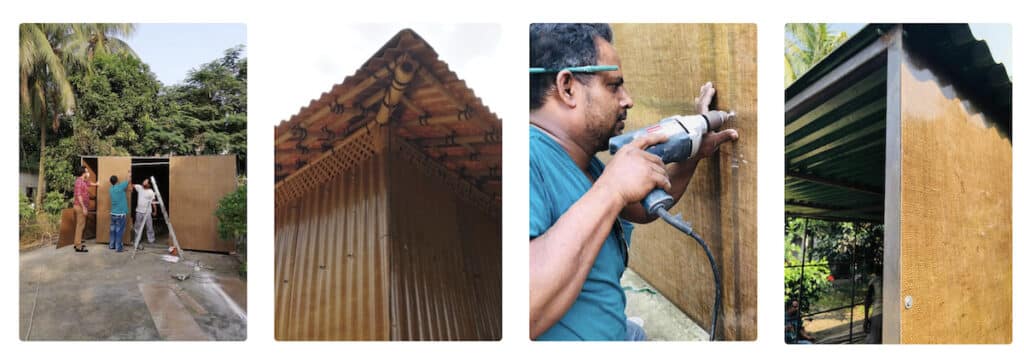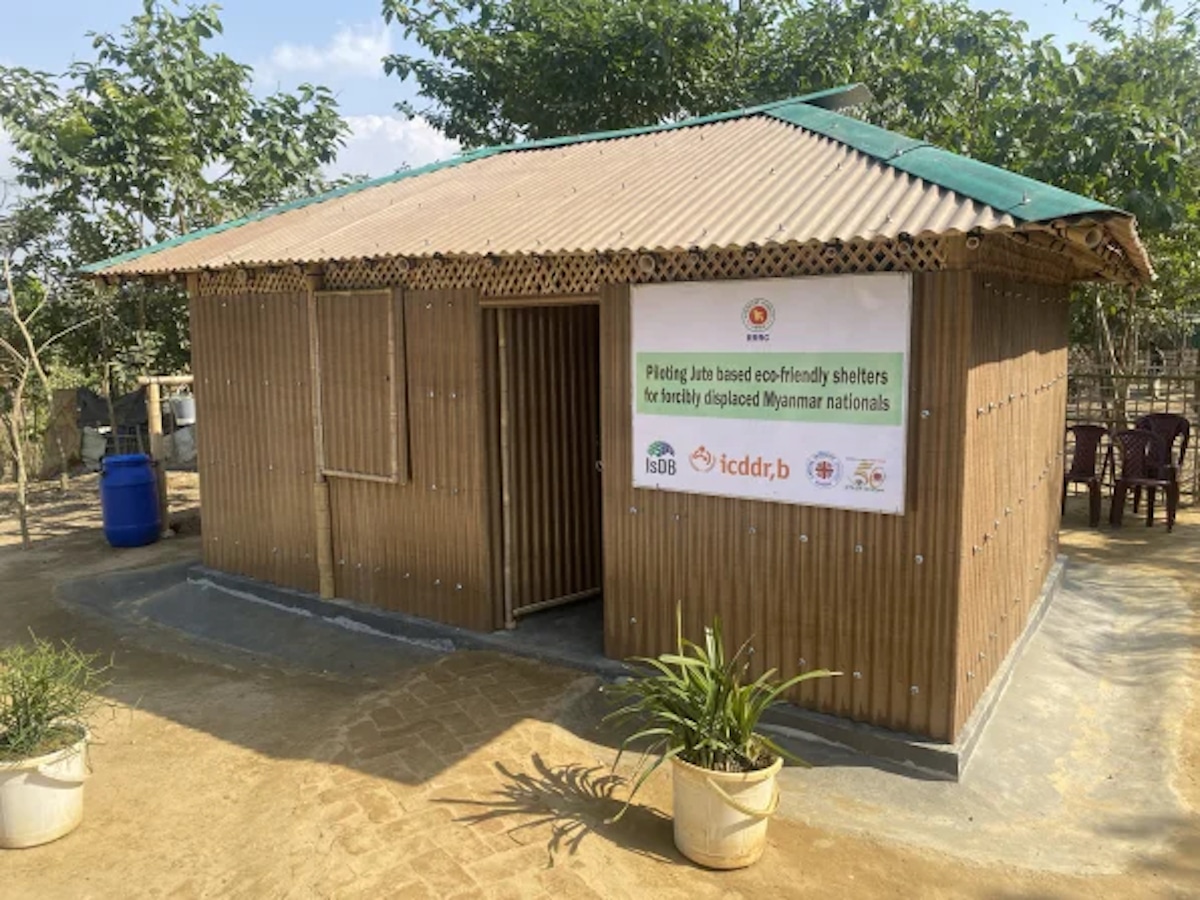Products You May Like
In 2021, war, persecution and other human rights abuses forced 89.3 million people to flee their homes. By 2050, the climate crisis could raise that number to more than one billion.
But in the immediate aftermath of an invasion or an extreme weather event, where will those people stay while waiting for a safe and permanent home? An Austin-based bioplastics startup and a Bangladeshi scientist have teamed up to develop a plant-based plastic that can be used to construct stable, dignified shelters for refugees.
“I want to be the transitionary housing of choice globally,” CEO of Applied Bioplastics Alex Blum told EcoWatch in an interview.
More From EcoWatch
From Dhaka to Austin
The homes are made from plant-based building blocks called BTTR Board internationally and jutin in Bangladesh. Jutin comes from jute, a plant that has been harvested in the country since ancient times but grew into a major international export from the subcontinent beginning in the 1790s.
“Unfortunately for the world and for the environment, and specifically for India and Bangladesh,” Blum said, the emergence of petrochemical alternatives to jute-woven burlap bags “destroyed the demand for jute.”
It is still grown in Bangladesh, which was the world’s top jute exporter in 2020, but it is not the money-maker for the country that it once was. However, around 25 years ago, Dr. Mubarak Ahmed Khan of Bangladesh, an award-winning scientist and former nuclear physicist, thought of another use for it. Why not transform the fiber into a building material for temporary shelters?
It was a meeting between Khan and Blum in 2017 that brought the idea into action. At the time, Blum, who had spent the previous decade working as a technology salesman, had closed his quota within the first two months of the year with a $500,000 commission check that he wanted to put towards a good cause.
“A friend of mine from college called me and told me that two million people had crossed the border into his home country of Bangladesh, and it looked like they needed help,” he said.
The friend invited Blum to stay with him and his family in Bangladesh to see what he could do.
“So I got on a plane, I flew to Bangladesh, and walked into what I later learned was the Rohingya genocide,” Blum said.
The Rohingya are an ethnic minority of Muslims living in what is now Myanmar who UN Secretary-General Antonio Guterres has described as “one of, if not the, most discriminated people in the world,” as BBC News reported. They began to flee across the border into Bangladesh en masse in August of 2017 following an escalation in military violence that the UN called a “textbook example of ethnic cleansing.” More than 900,000 Rohingya refugees now live in the Cox’s Bazar region of Bangladesh in what the United Nations High Commissioner for Refugees (UNHCR) calls the world’s largest refugee camp.
Blum quickly realized that $500,000 wouldn’t do much in the face of such massive displacement, so he decided to make a documentary about the situation, and that was how he met Khan.
“He’s one of these eccentric inventor types that has all these wonderful, crazy ideas but has never been able to commercialize them,” Blum said.
So Blum bought the idea from Khan and then hired him as Applied Bioplastics’s chief scientist in Bangladesh to help make it a reality.
“Our composite brings together the empowerment of rural agricultural communities and the traditional industries of Bangladesh to create a unique solution to modern problems, at scale,” Khan said in a statement shared with EcoWatch. “My invention will financially benefit Bangladesh while improving the living conditions of hundreds of thousands of people. I couldn’t be more proud to be a senior member of the Applied Bioplastics team, which is bringing my idea to life.”
Better Board
So how exactly does Applied Bioplastics turn jute into a home? First, the jute is woven into burlap. Then it’s layered on top of a tin base covered with a Mylar film, then treated with a proprietary chemical mixture that Blum says is non-toxic and food safe. Afterwards, the board is painted with thermoset resin and placed in a mold weighed down with bricks.

“That whole process takes about 45 minutes, and then you wait an hour and then you crack it out of the mold and you’ve got a wall,” Blum said.

The process is designed to be low-tech and doable by hand, though you can also use a heat press to speed it up. The cost of both labor and materials is around $1,000 for a house that measures 14 square meters (approximately 151 square feet) and 2.6 meters (approximately 8.5 feet) tall. And the result is definitely a step up from the tarpaulin structures that most of the Rohingya refugees living in Cox’s Bazar currently call home. In excerpts from a UNHCR, International Centre for Diarrhoeal Disease Research, Bangladesh (icddr,b) and Refugee Relief and Repatriation Commissioner of Bangladesh report shared by Applied Bioplastics, refugees said that the tarpaulin failed to keep out thieves and insects, easily caught fire and was vulnerable to storms.
“In the monsoon water easily enters the water through these tarpaulin,” one refugee said. “Tarp gets displaced if there is wind.”
However, since January 2022, Applied Bioplastics has joined with icddr,b and Catholic charity Caritas to launch a pilot program with six BTTR Board houses hosting six families. So far, reports from UNHCR and icddr,b have been favorable.
“They report better health outcomes, better dignity,” Blum said. “The people are happier and feel like they actually have a home.”
Unlike the leaky tarpaulin, the shelters even withstood a typhoon without any piece of the structure blowing away or injuring inhabitants.
Dr. Farjana Jahan, icddr,b Infectious Diseases Division assistant scientist of enteric and respiratory infections told EcoWatch that the new buildings impressed from the get go.
“While constructing the shelters, the impression of both icddr,b and shelter experts was satisfactory as we found this material can be easily assembled and fixed with the locally available tools. The masons were able to construct the shelters with minimal training,” Jahan said.
Housing the Future
The first phase of the pilot is now complete, though the families are welcome to continue using the homes.
“Various aid organizations including the UN may choose to purchase more homes due to the success of the pilot program,” Blum said.
Eventually, he is hoping to license the process to governments for $1 to $10 per home.
“I don’t want to make money on the suffering of others,” Blum said.
Unfortunately, it is likely that more suffering waits on the horizon. There is evidence that violence was perpetrated against the Rohingya partly to clear the way for an oil pipeline connecting the Persian Gulf and Africa to China. Many Rohingya live in the port town of Sittwe where the pipeline begins in Myanmar.
“There is a definite link between the oil development and the elimination of the Rohingya,” human rights advocate and Save the Rohingya founder Jamila Hanan told Oil Change International in 2013, even before the 2017 exodus. “The Rohingya are being cleared out of Sittwe which is being developed as a deep sea port to take oil tankers from the Middle East. There is huge number of economic developments around the port of Sittwe as a result of the new pipeline.”
But fossil fuels are displacing people all over the world in a different way because of the climate crisis — more than 20 million people have been forced from their homes because of flooding and extreme storms every year since 2008. And unless world leaders act quickly to curb fossil fuel emissions this decade, the number of the displaced will only rise. This includes in Bangladesh, which impressed Blum with its willingness to host hundreds of thousands of refugees while his neighbors in Texas complain about border crossings of a much smaller magnitude. Flooding in the low-lying country already unhouses people living on river islands, and as many as 30 million may be forced from their homes by 2100 if sea levels rise the anticipated 80 centimeters (approximately 31.5 inches), according to a 2022 study published in Frontiers in Psychology.
Jahan thought that jutin might house these people as well.
“We are piloting these houses both in Rohingya camp and host communities as [a] climate resilient infrastructure,” Jahan told EcoWatch. “We are planning to scale up these homes in other climate vulnerable regions of Bangladesh based on our pilot findings.”
Blum, meanwhile, is hoping for the licenses that would help expand BTTR Board to shelter the millions of people displaced by mounting disasters around the world, though he admitted frustration that the company had only so far been able to house six families since it launched almost four years ago.
“There’s no silver bullet to climate change. It’s going to take silver buckshot and we are part of the solution,” he said, “but a lot of the time, it feels like we’re putting a Band-Aid on for these housing displacements.”
